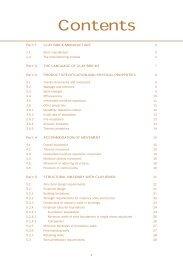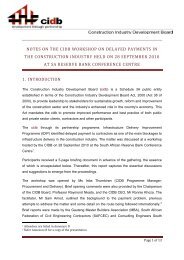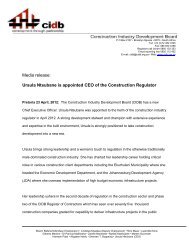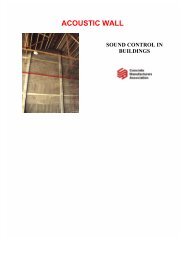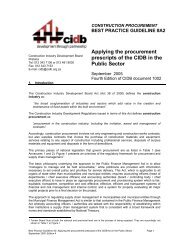MANUAL 4 - Construction Industry Development Board
MANUAL 4 - Construction Industry Development Board
MANUAL 4 - Construction Industry Development Board
Create successful ePaper yourself
Turn your PDF publications into a flip-book with our unique Google optimized e-Paper software.
MODULE<br />
1<br />
2<br />
3<br />
4<br />
5<br />
6<br />
7<br />
<strong>MANUAL</strong> 4 – BITUMINOUS PAVEMENT SEALS<br />
Photo 4.41<br />
• The mixing must produce a consistency which is creamy and although very soft when<br />
dropped from the mixer into the wheelbarrow (Photo 4.42), it will fall in similar fashion<br />
to fresh cow dung without splashing, with a tendency to flow outwards for some 60 to<br />
70 mm.<br />
Photo 4.42<br />
• The inside of the drum must be continually inspected for caking at the bottom of<br />
the drum. This will be evident when, after mixing for ± 2 min, a watery mixture of<br />
emulsion and aggregate (poorly graded) appears to form. Some of the aggregate will<br />
have caked at the bottom of the drum.<br />
• This will occur if the operator has kept the drum in the semi-vertical position for<br />
extended periods while mixing. To rectify this situation, place the drum in the near<br />
horizontal position and tap the base of the drum with a 2 kg hammer. Immediately the<br />
cake will be released and the mixture will revert to the creamy smooth mixture.<br />
The operator of the concrete mixer is in charge of the discharging operations and must<br />
ensure the barrows are correctly placed, so that when discharging of the drum occurs, the<br />
slurry falls well within the bowl of the barrow without any wastage or mess taking place<br />
(Photo 4.42). Only half barrow loads must be discharged and not full loads.<br />
IMPLEMENTING EMPLOYMENT INTENSIVE ROAD WORKS 64





